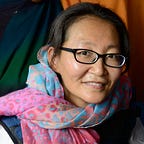Healthy little seeds for strong little bodies
Linthong tries to peek over his classmates’ shoulders to see what’s for lunch today. “Lentils,” he turns to grin at his friend Sa, who eagerly reaches to get his food tray. The friends sit down at their desks and start digging in: The fried rice on their tray contains carrot, pumpkin and lentils, and the soup is made with fish, morning glory, herbs and spices.
The boys live in the remote village of Thaenkhaen by the banks of the Ou river in Luang Prabang province, reachable only by boat and several hours of driving on a bumpy dirt track. The primary school students in Thaenkhaen are receiving daily healthy lunches — cooked with rice, lentils and fish — are part of the school meals program supported by the United Nations World Food Programme (WFP) with funding from the United States Government.
Linthong and Sa are among 63,000 children studying in 916 primary schools across Laos that are supported by WFP, an organization that works with the Government to prevent hunger and reduce malnutrition, believing that the development of a strong body and mind must be fueled with enough healthy food. In Luang Prabang province, 41% of children under the age of five are not growing adequately and reaching the height they should at their age, which also results in impaired learning capacities and a reduced life potential.
Ms. Manivanh, a permanent community cook at Thaenkhaen primary school, shares her experiences with lentils — a food not known in Laos. “It took me a little while to get used to the smell and taste of lentils, and to learn how to make tasty meals with them,” she says. “The children like them now, especially when they are added to stir fries or soup.”
Lentils are an excellent replacement for meat, which is hard to find in remote, poor villages in Laos. “We are experimenting with lentil curd and milk, and the children love the lentil laap we have started to prepare,” says WFP District Community Facilitator Syvongxay in Houn district, Oudomxay province. “At the same time, we teach them how to grow nutritious food that is local, so that soon, they don’t need our support anymore.”
Lentils contain high amounts of protein, vitamins and minerals, but so do a variety of beans that can be grown locally. Leafy greans, herbs and beans grown in WFP-supported school gardens find their way into the school lunches, while children learn about good nutrition and how to grow their own healthy food. The benefits of the school meals programme are reflected in stronger health and better concentration in class. School meals also motivate children to go to school and stay in school for longer — up to one year longer than those who do not receive school lunches. For Linthong and Sa, the benefits are as tasty as a mouthful of fried rice with lentils — a great start to a bright future.
